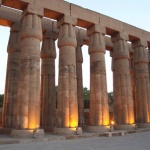Description Luxor, Egypt
 Luxor's most popular tourist center of Egypt, the glory of having "the largest open-air museum". It remained the most magnificent temples of ancient Egypt, the Valley of the Kings with the tomb of Tutankhamen, Colossi of Memnon and many other monuments, which will impress even the most experienced traveler.
Luxor's most popular tourist center of Egypt, the glory of having "the largest open-air museum". It remained the most magnificent temples of ancient Egypt, the Valley of the Kings with the tomb of Tutankhamen, Colossi of Memnon and many other monuments, which will impress even the most experienced traveler. Luxor is located 650 km south of Cairo and 280 km from Hurghada (5 hrs drive).
Probably will not be an exaggeration to say that he who, having visited Egypt, has not visited Luxor - did not see the point. It is particularly strongly felt ancient Egyptian lands, and seemed to revive traditions and legends, in fact literally under every house of the city - the foundations of ancient temples and palaces, alleys sphinxes and fragments of the destroyed statues.
It is here that once were grand capital of the ancient Egyptian state, which the ancient Egyptians called the "Uaset, the Greeks -" Thebes "and the Arabs - Al-Uksur" - "palaces". Ancient Thebans themselves in texts is often called by their country simply "Niut" or "City".
In ancient Thebes, situated on both banks of the Nile. On the east - two magnificent temple - Karnak and Luxor, United alleys sphinxes. The majestic temple complexes coexisted here with luxurious palaces, noble houses, gardens, rare trees and artificial lakes. In the lapis lazuli sky pierced gilt needle obelisks, painted the top of the temple towers, pylons and colossal statues of kings.
Through the lush green tamarisk, sycamore, and lined with date palms betrayed turquoise-green tiles window openings rich houses. Subjugated peoples of Syria-Palestine were brought here countless wine vessels, skin, so beloved by the Egyptians and the product of semi-precious lapis lazuli crafts from distant areas of Africa, caravans, laden with ivory, ebony, spices and gold.
On the other bank of the Nile, in the western part of Thebes, was the royal residence and a huge necropolis, located in the amphitheater of cliffs, over which rises Dehenet - "Western summit, known now as Qurnah. Snake Goddess Meretseger, loving silence, "Lady of the mountain, according to legend, protects not only the king's burial, located in the Valley of the Kings and Valley of the queens, but also the tombs of nobles and ordinary citizens.
Giant statues of Pharaoh Amenhotep III, who called the Colossi of Memnon History, welcome each traveler at the border of green wheat fields and lifeless desert sands. Once they stood before a giant memorial complex of the lord, alas, did not withstand the battle with time.
History of Thebes, leaving the darkness of the century: the first mention of the city preserved in the texts, dating from the III millennium BC However sumptuous flowering of the city was preceded by a long history. In the 21 century. BC he was the first time in a short time became the capital in the XI dynasty of pharaohs of the Middle Kingdom. It was in this era in Thebes began active construction of monumental shrines to the gods and the dead kings.
Since the beginning of the New Kingdom, in 16. BC for the city began the period of greatest prosperity. Even centuries later, in the Greco-Roman times, when the capital was moved to Alexandria, Thebes retained its role as a major cultural and religious center of Egypt.
The unique monuments of ancient art found in the city and associated with all phases of its history can be seen in the most interesting exhibits of the Egyptian Museum, Luksorkogo Museum and the Museum of mummification. However, the entire Luxor - is an amazing and unique outdoor museum, which combines in indissoluble unity of the century and the era, the rulers and culture.